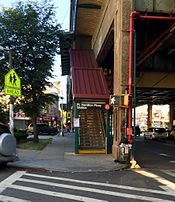Fort Hamilton Parkway | ||||||||||||||||||||||||||||||||||||||||||||||||||||||||||||||||||||
|---|---|---|---|---|---|---|---|---|---|---|---|---|---|---|---|---|---|---|---|---|---|---|---|---|---|---|---|---|---|---|---|---|---|---|---|---|---|---|---|---|---|---|---|---|---|---|---|---|---|---|---|---|---|---|---|---|---|---|---|---|---|---|---|---|---|---|---|---|
|
| ||||||||||||||||||||||||||||||||||||||||||||||||||||||||||||||||||||
 Platforms view | ||||||||||||||||||||||||||||||||||||||||||||||||||||||||||||||||||||
| Station statistics | ||||||||||||||||||||||||||||||||||||||||||||||||||||||||||||||||||||
| Address | Fort Hamilton Parkway & New Utrecht Avenue Brooklyn, NY 11219 | |||||||||||||||||||||||||||||||||||||||||||||||||||||||||||||||||||
| Borough | Brooklyn | |||||||||||||||||||||||||||||||||||||||||||||||||||||||||||||||||||
| Locale | Borough Park | |||||||||||||||||||||||||||||||||||||||||||||||||||||||||||||||||||
| Coordinates | 40°38′27″N 73°59′40″W / 40.6407°N 73.9944°W | |||||||||||||||||||||||||||||||||||||||||||||||||||||||||||||||||||
| Division | B ( BMT) [1] | |||||||||||||||||||||||||||||||||||||||||||||||||||||||||||||||||||
| Line | BMT West End Line | |||||||||||||||||||||||||||||||||||||||||||||||||||||||||||||||||||
| Services |
D
| |||||||||||||||||||||||||||||||||||||||||||||||||||||||||||||||||||
| Structure | Elevated | |||||||||||||||||||||||||||||||||||||||||||||||||||||||||||||||||||
| Platforms | 2 side platforms | |||||||||||||||||||||||||||||||||||||||||||||||||||||||||||||||||||
| Tracks | 3 (2 in regular service) | |||||||||||||||||||||||||||||||||||||||||||||||||||||||||||||||||||
| Other information | ||||||||||||||||||||||||||||||||||||||||||||||||||||||||||||||||||||
| Opened | June 24, 1916 | |||||||||||||||||||||||||||||||||||||||||||||||||||||||||||||||||||
| Opposite- direction transfer | Yes | |||||||||||||||||||||||||||||||||||||||||||||||||||||||||||||||||||
| Traffic | ||||||||||||||||||||||||||||||||||||||||||||||||||||||||||||||||||||
| 2023 | 873,254
[2] | |||||||||||||||||||||||||||||||||||||||||||||||||||||||||||||||||||
| Rank | 314 out of 423 [2] | |||||||||||||||||||||||||||||||||||||||||||||||||||||||||||||||||||
| ||||||||||||||||||||||||||||||||||||||||||||||||||||||||||||||||||||
| ||||||||||||||||||||||||||||||||||||||||||||||||||||||||||||||||||||
| ||||||||||||||||||||||||||||||||||||||||||||||||||||||||||||||||||||
| ||||||||||||||||||||||||||||||||||||||||||||||||||||||||||||||||||||
| ||||||||||||||||||||||||||||||||||||||||||||||||||||||||||||||||||||
The Fort Hamilton Parkway station is a local station on the BMT West End Line of the New York City Subway, located in Brooklyn at the intersection of Fort Hamilton Parkway and New Utrecht Avenue, in the neighborhood of Borough Park. It is served by the D train at all times. The station opened in 1916, and had its platforms extended in the 1960s.
History
Fort Hamilton Parkway station opened on June 24, 1916, along with the first portion of the BMT West End Line from 36th Street on the BMT Fourth Avenue Line to 18th Avenue station. [3] [4] The line was originally a surface excursion railway to Coney Island, called the Brooklyn, Bath and Coney Island Railroad, which was established in 1862, but did not reach Coney Island until 1864. [5] Under the Dual Contracts of 1913, an elevated line was built over New Utrecht Avenue, 86th Street and Stillwell Avenue. [6] [7] [8]
The platforms at the station were extended in the 1960s to 615 feet (187 m) to accommodate ten-car trains.[ citation needed]
Station layout
| Platform level | Side platform | |
| Northbound local | ←
| |
| Peak-direction express | No regular service | |
| Southbound local |
| |
| Side platform | ||
| Mezzanine | Fare control, station agent, MetroCard machines | |
| Ground | Street level | Entrance/exit |

This elevated station has three tracks and two slightly offset side platforms. The D train stops here at all times, and the center express track is not normally used in service. [9] [10] Both platforms have cream-colored windscreens and red canopies, both supported by green frames and columns, for most of their centers. Their ends have steel waist-high fencing.
The station's artwork, installed during a 2012 renovation, is called Gardens of Fort Hamilton Parkway Station by Portia Munson. It consists of stained glass murals on the platform windscreens depicting various plants.
Exits
This station has two station houses beneath the platforms and tracks. The full-time one is at the south end. It has two staircases to each platform, a waiting area/crossunder, turnstile bank, token booth, and staircases going down to either northern corners of New Utrecht Avenue and 45th Street. [11] The northern station house is abandoned. A single staircase from each platform goes down to a walkway on either side of the building, where a turnstile provides access to and from the station. Two staircases go down to either side of New Utrecht Avenue between 44th and 43rd Streets. [11]
References
- ^ "Glossary". Second Avenue Subway Supplemental Draft Environmental Impact Statement (SDEIS) (PDF). Vol. 1. Metropolitan Transportation Authority. March 4, 2003. pp. 1–2. Archived from the original (PDF) on February 26, 2021. Retrieved January 1, 2021.
- ^ a b "Annual Subway Ridership (2018–2023)". Metropolitan Transportation Authority. 2023. Retrieved April 20, 2024.
- ^ "Parade, Pageant Mark Celebration". The Brooklyn Daily Eagle. June 24, 1916. p. 8. Retrieved September 16, 2015.
- ^ "Realty Boom Is Predicted for Borough Park Section". The Brooklyn Daily Eagle. June 24, 1916. p. 8. Retrieved September 16, 2015.
- ^ "Opening of the Brooklyn, Bath and Coney Island Railroad" (PDF). The New York Times. June 9, 1864. p. 2. Retrieved July 28, 2020.
- ^ "The Dual System of Rapid Transit". New York State Public Service Commission. September 1912. Retrieved March 25, 2014.
- ^ "618 Miles of Track In The Dual System; City Will Have Invested $226,000,000 When Rapid Transit Project Is Completed". The New York Times. August 3, 1913. Retrieved April 25, 2018.
- ^ Report of the Public Service Commission For The First District Of The State of New York For The Year Ending December 31, 1916 Vol. 1. New York State Public Service Commission. January 10, 1917. pp. 47–49.
- ^ Dougherty, Peter (2020). Tracks of the New York City Subway 2020 (16th ed.). Dougherty. OCLC 1056711733.
- ^ "D Subway Timetable, Effective January 23, 2023". Metropolitan Transportation Authority. Retrieved August 26, 2023.
- ^ a b "Fort Hamilton Parkway Neighborhood Map". mta.info. Metropolitan Transportation Authority. 2018. Retrieved July 16, 2020.
External links
- nycsubway.org – BMT West End Line: Fort Hamilton Parkway
- Station Reporter — D Train
- The Subway Nut — Fort Hamilton Parkway Pictures
- 45th Street entrance from Google Maps Street View
- 44th Street entrance from Google Maps Street View
- Platforms from Google Maps Street View


